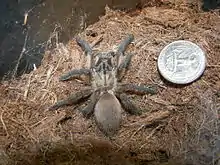| Eumenophorinae | |
|---|---|
 | |
| Monocentropus balfouri | |
| Scientific classification | |
| Domain: | Eukaryota |
| Kingdom: | Animalia |
| Phylum: | Arthropoda |
| Subphylum: | Chelicerata |
| Class: | Arachnida |
| Order: | Araneae |
| Infraorder: | Mygalomorphae |
| Family: | Theraphosidae |
| Subfamily: | Eumenophorinae Pocock, 1897[1] |
| Genera | |
|
See text. | |
The Eumenophorinae are a subfamily of tarantula spiders (family Theraphosidae). They are known from genera distributed across Sub-Saharan Africa, the south of the Arabian peninsula, Madagascar and its associated islands, and parts of India.[2]
Distribution
At about 158-160 million years ago (Mya), Gondwana split up and the Indo-Madagascan plate drifted away from the rest of the super continent. At around 84-86 Mya, India split from Madagascar and drifted into Eurasia (66-55 Mya), to its current position. Therefore, all fauna in Gondwana (such as the Eumenophorinae) would be distributed on all three land masses.[2]
Characteristics
The Eumenophorinae have stridulatory spike setae on the coxae of all legs, and a "comb" of stiffened setae on the palpal femur. In 2005, Richard Gallon described the monotypic genus Mascaraneus, which lacks the stridulatory spike setae.[2]
Taxonomy
The monophyly of the Eumenophorinae has been confirmed in a number of molecular phylogenetic studies. However, these have included relatively few of the genera that have been placed in the subfamily at one time or another. A 2014 study included Anoploscelus and Phoneyusa.[3] A 2018 study included Hysterocrates, Monocentropus and Pelinobius.[4]
Genera
Genera that have been placed in the subfamily Eumenophorinae by various sources include:
- Annandaliella Hirst, 1909[4]
- Anoploscelus Pocock, 1897[5]
- Batesiella Pocock, 1903[5]
- Encyocrates Simon, 1892[1][5]
- Eumenophorus Pocock, 1897[1][5]
- Heterophrictus Pocock, 1900[2]
- Heteroscodra Pocock, 1900[1]
- Hysterocrates Simon, 1892[1][5]
- Loxomphalia Simon, 1889[1][5]
- Loxoptygus Simon, 1903[1][5]
- Mascaraneus Gallon, 2005[6]
- Monocentropus Pocock, 1897[1][5]
- Myostola Simon, 1903[1][5]
- Neoheterophrictus Siliwal & Raven, 2012[2]
- Pelinobius Karsch, 1885 (as Citharischius Pocock, 1900)[1][5]
- Phoneyusa Karsch, 1884[1][5]
- Plesiophrictus Pocock, 1899[2]
- Sahydroaraneus Mirza & Sanap, 2014[2]
- Stromatopelma Karsch, 1881[1]
References
- 1 2 3 4 5 6 7 8 9 10 11 12 Raven, R.J. (1985). "The spider infraorder Mygalomorphae (Araneae): Cladistics and systematics". Bulletin of the American Museum of Natural History. 182: 1–180. hdl:2246/955.
- 1 2 3 4 5 6 7 Mirza, Z.A.; Sanap, R.V. & Bhosale, H. (2014). "Preliminary review of Indian Eumenophorinae (Araneae: Theraphosidae) with description of a new genus and five new species from the Western Ghats". PLOS ONE. 9 (2): e87928. doi:10.1371/journal.pone.0087928. PMC 3925112. PMID 24551072.
- ↑ Guadanucci, J.P.L. (2014). "Theraphosidae phylogeny: relationships of the 'Ischnocolinae' genera (Araneae, Mygalomorphae)". Zoologica Scripta. 43 (5): 508–518. doi:10.1111/zsc.12065. S2CID 86484123.
- 1 2 Lüddecke, Tim; Krehenwinkel, Henrik; Canning, Gregory; Glaw, Frank; Longhorne, Stuart J.; Tänzler, René; Wendt, Ingo & Vences, Miguel (2018). "Discovering the silk road: Nuclear and mitochondrial sequence data resolve the phylogenetic relationships among theraphosid spider subfamilies". Molecular Phylogenetics and Evolution. 119: 63–70. doi:10.1016/j.ympev.2017.10.015.
- 1 2 3 4 5 6 7 8 9 10 11 Schmidt, G. (2003). "8.6 Eumenophorinae Pocock, 1897". Die Vogelspinnen: Eine weltweite Übersicht. Neue Brehm-Bücherei. Hohenwarsleben: Westarp Wissenschaften. pp. 207–216. ISBN 978-3-89432-899-3.
- ↑ Gallon, R.C. (2005). "On a new genus and species of theraphosid spider from Serpent Island, Mauritius (Araneae, Theraphosidae, Eumenophorinae)" (PDF). Bulletin of the British Arachnological Society. 13: 175–178. Archived from the original (PDF) on 2016-03-03. Retrieved 2016-02-07.